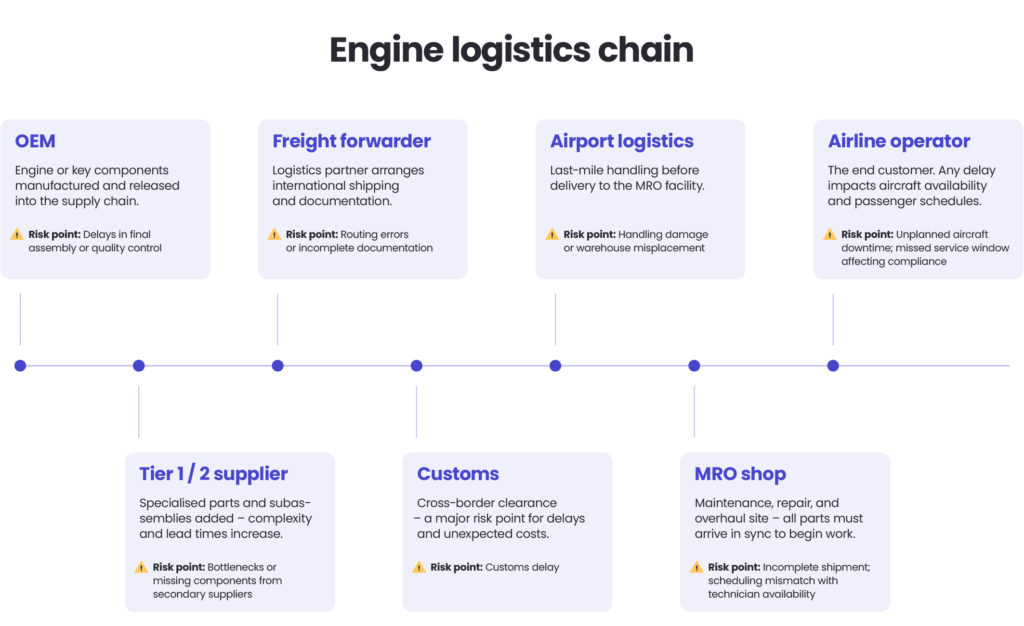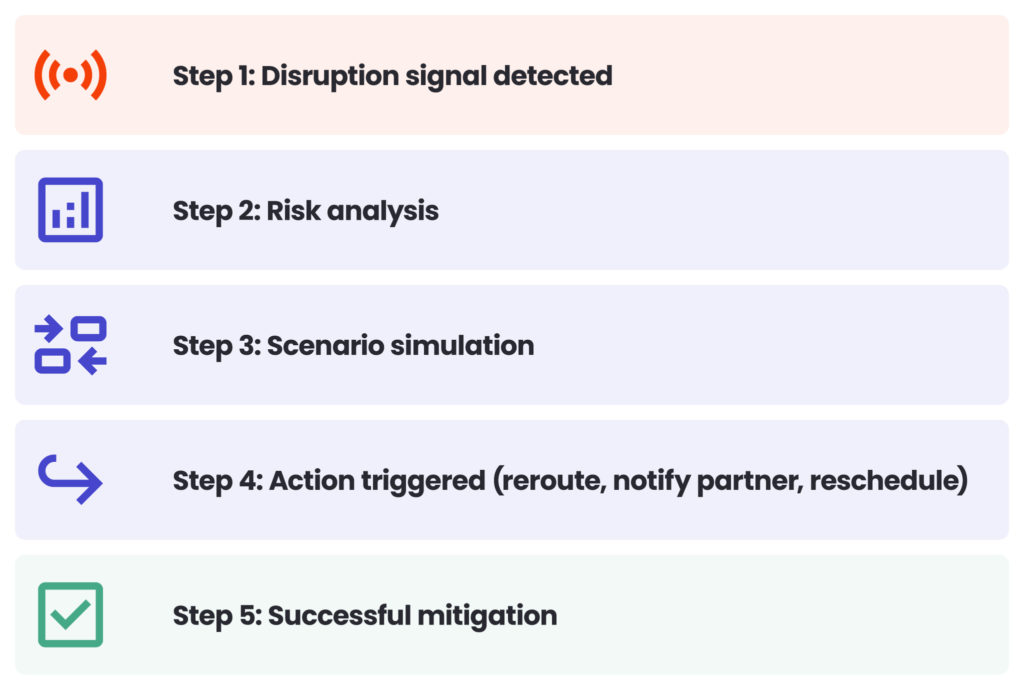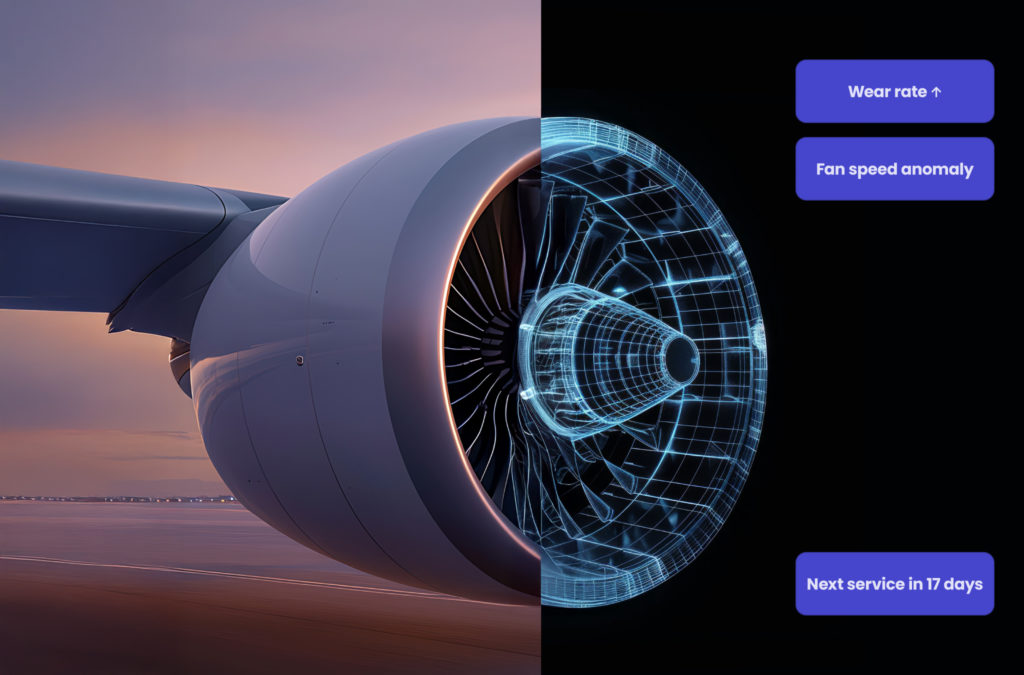From factory to wing: Orchestrating engine logistics with AI
It’s Monday morning at a maintenance facility outside Paris. The shop floor is ready, technicians are briefed, and the incoming engine is expected to arrive any minute. But it doesn’t arrive. It’s still sitting in a warehouse near Prague, waiting for export clearance. The fan blades? Already here, delivered early thanks to an auto-scheduled shipment that didn’t align with the engine’s actual transit timeline. So now the parts sit idle, the shop crew waits, and yet another job is delayed – just because of the lack of coordination, costing thousands every hour.
Situations like this aren’t rare. They’re happening every day, all over the world.
It’s a familiar failure in modern engine logistics: all systems are functioning, but coordination is lacking. A customs delay here, a missed shipment window there, and suddenly your carefully planned operation collapses.
In this article, we explore how AI changes this dynamic. Not only does it describe what’s happening across the supply chain, but it actively coordinates it as well. You’ll see that a shift toward a smarter future is possible – one where data doesn’t just inform but connects, anticipates, and drives action.
The high-stakes reality of engine logistics
Many industries talk about complexity and pressure. In aerospace engine logistics, it’s the baseline – and there’s zero margin for error.
Each unit moves through a labyrinth of multiple players: OEMs, Tier 1 and Tier 2 suppliers, MRO shops, airlines, freight operators, airport authorities, and customs officials. Each has its own regulatory requirements, legal frameworks, and digital systems.

This complexity can lead to problems:
- Engines may arrive before the shop floor is ready to receive them.
- The wrong spare parts may be delivered, or the right parts may not be delivered.
- Maintenance slots may be missed, making technicians unavailable when needed later.
- Aircraft stay grounded, waiting for a single missing component.
This is the everyday reality of a fragmented logistics ecosystem. McKinsey calls it “continued turbulence” in aerospace supply chains: long lead times, minimal buffer capacity, and chronic unpredictability that didn’t end with the pandemic.
And while the pain is shared, no single stakeholder controls the full picture. OEMs, MROs, and logistics partners all manage different slices of the process.
Real transformation requires shared incentives, engagement, mutual visibility, and platforms designed to benefit every player in the chain. We know it’s a complex challenge – but not an unsolvable one.
The message is clear: the industry doesn’t just need faster shipping or better tracking. It needs a proactive, intelligent operating model. One that sees across silos, anticipates risks, and keeps everything (and everyone) in sync.
Why orchestration only works when everyone wins
Crucially, no single stakeholder can transform the aerospace supply chain alone. The system is too interconnected and too interdependent. An engine delay in one facility creates a cascading effect on multiple partners. Therefore, orchestration only works when the entire ecosystem is aligned.
That’s why collaboration must be built into the system from day one, rather than added as an afterthought. Without shared visibility, synchronised timelines, and aligned incentives, even the most advanced AI can’t fix a fragmented process.
Let’s build better engine logistics together
Tell us about your challengesIn traditional aerospace logistics, each participant (OEMs, MROs, freight forwarders, customs, airlines) tends to optimise for their own KPIs. When logistics orchestration enters the picture, every link in the chain must have a reason to pull in the same direction. The win condition becomes: everyone must stay in sync and deliver on time.
So, how do you make this work in practice?
All stakeholders have to benefit from coordination. This means:
- Embedding collaboration in contracts – for example, introducing shared service level agreements (SLAs) among OEMs, MROs, and logistics providers that measure collective outcomes (like end-to-end turnaround time or engine downtime reduction), instead of focusing on isolated tasks.
- Creating secure data environments where sensitive information (engine health, shipment timing, availability) can be shared selectively, complete with audit trails and role-based access.
- Establishing governance models to jointly oversee orchestration efforts, track progress, and continuously refine coordination processes.
- Offering incentive structures that reward joint success – e.g. penalties for delays that impact shared KPIs.
What AI-driven engine logistics REALLY looks like
What if every stakeholder in the engine logistics chain could operate from a shared, intelligent source of truth? Not just tracking events as they happen, but anticipating what’s coming and adjusting in real-time. This is what next-generation logistics orchestration makes possible.
By integrating a wide range of data sources (from IoT sensors, GPS tags, ERP records, airline schedules, MRO slots, weather patterns, and customs data) AI-powered logistics creates an end-to-end understanding of engine movement across teams, borders, and time zones. It shows where things are, where they’re going, and what might get in the way.

Behind the scenes, this is made possible by a stack of interconnected technologies – including RFID tracking, 5G connectivity, edge computing, and cloud-based API integrations – that ensure data flows seamlessly and decisions are made in real-time.
However, the visibility is only the beginning. The real strength lies in anticipation. AI can detect early signs of disruption by recognising patterns, and then trigger an appropriate action. For example, it might reroute an engine days before a delay occurs or automatically trigger contingency plans across different time zones.
According to McKinsey, supply chains using AI-based risk prediction can reduce the impact of disruptions by up to 30%.

The true value? Logistics that proactively think ahead – simulating scenarios, forecasting outcomes, and initiating response actions. This transition from descriptive dashboards to predictive engines is what’s transforming aerospace logistics.
Predictive maintenance meets predictive logistics
Predictive maintenance has already changed the way airlines and MROs view engine health. What if we could apply that same intelligence throughout the entire logistics chain?
Imagine a world where every performance anomaly and subtle deviation in engine behaviour directly informs supply chain planning – not merely as a data point to be analysed later, but as a trigger for real-time action.
Digital twins make this possible. These virtual replicas of physical engines simulate wear, track usage patterns, and forecast potential failures with remarkable accuracy.
For example, GE Aerospace uses digital twin models to predict the need for replacement parts months in advance. This insight allows for just-in-time shipping of parts, precise booking of maintenance slots, reduced engine downtime, and optimised workloads across various facilities.

By integrating predictive engine data directly into logistics workflows, the system can trigger early shipments, adjust inventory allocations, and align supply chain actions with actual engine needs.
Predictive planning months in advance = just-in-time shipping + reduced downtime, keeping engine logistics running like clockwork.
When predictive maintenance and predictive logistics work hand in hand, the outcome is a fully synchronised operation.
Orchestration in action
What does intelligent orchestration actually look like on the ground? Imagine this scenario:
- An engine currently flying daily routes begins to show subtle signs of turbine stress.
- The system springs into motion and responds by coordinating the following: replacement part is automatically sourced and assigned – AI cross-checks current inventory levels, part compatibility, and repair facility availability to determine the optimal match – maintenance window is booked at the nearest facility that has the right equipment and capacity – shipping is arranged based on real-time traffic, weather conditions, and customs clearance data.
- Delay occurs: the shipment gets held up in transit.
- Instead of discovering this in a reactive manner, the system flags the issue immediately and automatically alerts the right local contact.
- By the time the aircraft lands, the part is already waiting.
- The crew can get to work without delay.
The outcome? Minimal aircraft downtime and no emergency shipments. The plane returns to service early – saving money, keeping schedules intact, and maintaining operational trust.
Making it work: Technology and people
While the technology is powerful, true logistics orchestration isn’t solely digital. Success depends on human collaboration across manufacturing, maintenance, logistics, and operations.
This is why the aerospace leaders are rethinking collaboration from the ground up. They are:
- Merging real-world engine performance data with production schedules to anticipate demand.
- Aligning engineering, logistics, and operations teams around shared timelines and common objectives.
- Creating secure digital workspaces where OEMs, MROs, and logistics partners can see the same data, plan in the same environment, and act with the same urgency.
In this model, AI doesn’t replace human decision-making but enhances it.
AI identifies risks earlier and presents options more quickly, while people remain essential for judgment, trade-offs, and approvals – a true human-in-the-loop model.
Data security and sovereignty
When it comes to engine performance, maintenance records, and supply chain movements, every byte of data is valuable and potentially vulnerable.
Understandably, many stakeholders across the aerospace ecosystem are concerned about sensitive engine performance and maintenance data being shared across different systems. This is where best-practice security frameworks become essential.

At Spyrosoft, our AI logistics platforms are designed with several key features:
- End-to-end encryption, securing data in transit and at rest, across all partners and platforms.
- Role-based access controls, ensuring only the right eyes see the right data.
- Compliance with global standards – ISO 27001, NIST, AS9100, and aviation-specific frameworks to ensure the highest level of security.
- Sovereign data strategies where regional storage, processing, and transfer policies are respected, giving stakeholders control over where their data is stored and how it moves.
We work closely with clients, regulators, and industry alliances to help establish standards that define what secure and collaborative logistics should look like within a connected aviation ecosystem.
Conclusion: Clear skies ahead with AI logistics
When engines arrive late or components go missing, it’s not just a delay or a paperwork issue. It’s lost revenue, eroded trust, and a ripple effect that reaches from the hangar to the passenger gate.
Read more: How AI solves aviation’s maintenance capacity crunch
Go to the articleThat’s why it’s so important to reimagine logistics in the aviation industry. The benefits are tangible:
- Faster turnarounds.
- Higher fleet availability.
- Reduced operating costs.
- Stronger customer loyalty.
In a high-stakes aviation industry, the winners will be those who can deliver engines and components on time, every time – with intelligent coordination from end to end.
At Spyrosoft, we help make it real. We create data platforms and AI solutions that connect the dots – from engine telemetry to customs clearance.
If you’re ready to simplify your engine logistics with AI, let’s talk.
About the author
Contact us

![[hero] predictive engines 2](https://spyro-soft.com/wp-content/uploads/2025/06/hero-predictive-engines-2-300x160.jpeg)
![[hero] predictive engines 1](https://spyro-soft.com/wp-content/uploads/2025/06/hero-predictive-engines-1-300x169.jpeg)



